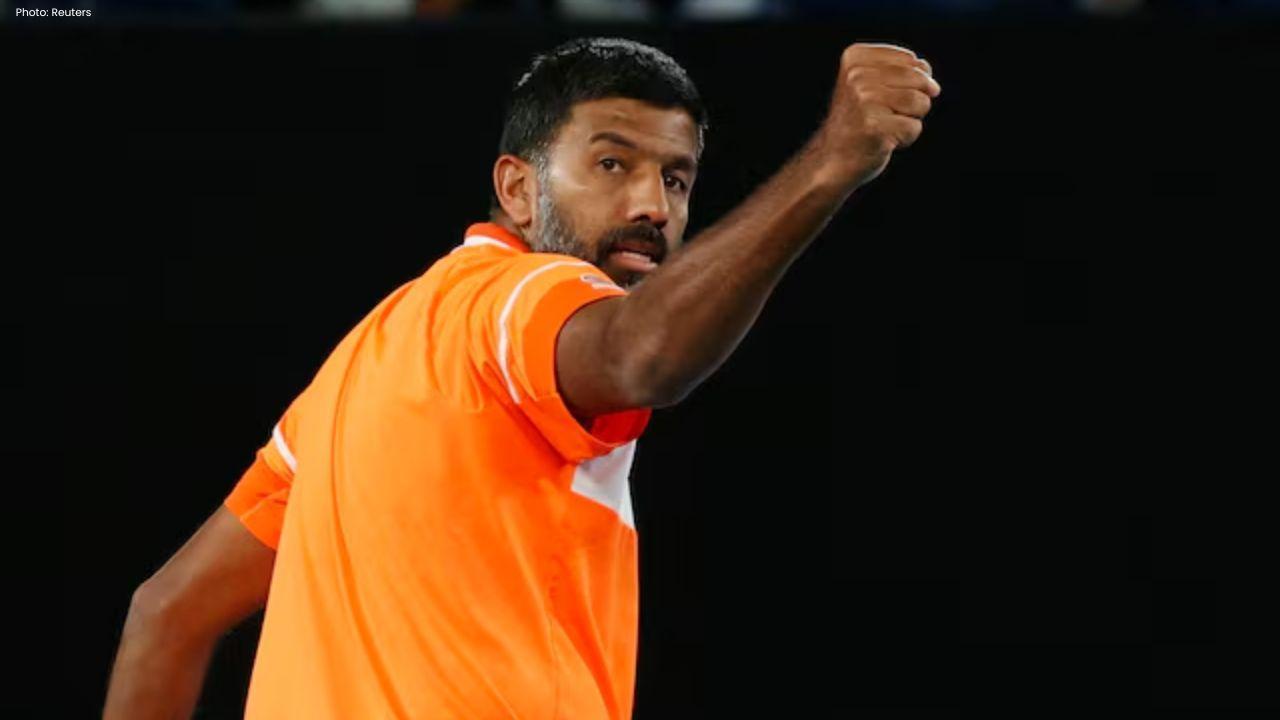
Post by : Jyoti Singh
Photo: Reuters
Jonathan Edwards’ 30-Year-Old Triple Jump Record Still Untouched. August 7, 2025 – Gothenburg, Sweden / London, UK. Today marks 30 years since British athlete Jonathan Edwards set his unbelievable triple jump world record of 18.29 metres at the World Championships in Gothenburg in 1995. The record, which many believed would be broken within a few years, has now stood the test of time — and surprisingly, no athlete has jumped further under fair wind conditions since that historic day. Edwards, now 59, says he still feels proud of the achievement, but also a little surprised — and even a bit concerned — that the record has lasted so long.
I don’t think it’s a good sign for athletics when a record lasts 30 years, Edwards told BBC Sport. With all the improvements in sports science, training, and nutrition, it doesn’t reflect well on the current state of the sport.
A Day That Changed Athletics History
On August 7, 1995, at the Ullevi Stadium in Gothenburg, Jonathan Edwards did something no athlete had done before — he jumped beyond 18 metres in legal wind conditions. Not just once, but twice in the same event. In his first attempt, Edwards leapt 18.16m, shocking the crowd and his competitors. Just 20 minutes later, he broke his fresh record by landing a massive 18.29m, which remains the world record to this day.
At the time, this was one of the greatest performances ever seen in British athletics. Edwards had already jumped 17.98m earlier that season to break the previous record held by American Willie Banks. He had also recorded a wind-assisted jump of 18.43m, but that one didn’t count for the record books due to strong tailwinds.
What made his performance even more special was that no one else had ever crossed the 18m mark legally before. Since then, only seven other men have ever jumped over 18 metres — but none have come close to 18.29m.
What Made Edwards So Good?
Edwards was known not just for his strength, but also for his speed and technique. He often described himself more as a sprinter than a jumper. At just 71kg, he was lighter than most of his competitors, and he moved with quick, balanced steps through the phases of the triple jump — the hop, step, and jump.
That year, he also changed his jumping style switching to a double-arm action instead of alternating his arms. He said this helped him stay so well balanced in the air and through his phases.
Interestingly, Edwards admitted he was nervous before the competition. He even bought sunglasses at the airport so his rivals wouldn’t see the fear in his eyes during warm-ups. But once the event began, the nerves disappeared, and history was made.
His rivals were amazed. Bronze medallist Jerome Romain said, We studied Edwards’ videos every day. What he did was just remarkable. Silver medallist Brian Wellman added, He was the most efficient triple jumper out there.
Why Has the Record Lasted So Long?
Many people believe that records are meant to be broken. But Edwards’ record has lasted longer than anyone expected. He believes that one big reason is that athletics has not grown or improved as much as other sports over the past three decades.
The sport hasn’t kept up with the times, Edwards said. If you’re a talented young athlete today, you probably won’t choose triple jump — or even athletics — because other sports offer better rewards and more money.
He explained that field events like the triple jump don’t get as much attention or support compared to other sports. When four-time Olympic champion Michael Johnson launched a new track event this year offering big prize money, only track races were included — field events were left out.
Less Funding, Fewer Young Athletes
Support for athletics is also dropping in many countries. In the UK, for example, the main sports body — UK Sport — recently announced a second straight funding cut for athletics. The amount going to UK Athletics for the 2028 Olympics will be 8% lower than what they received for Paris 2024.
Meanwhile, fewer young people are joining or sticking with track and field. According to England Athletics participation is falling and more and more young athletes are quitting.
All of this means the talent pool is shrinking — and the chance of someone breaking Edwards’ record gets smaller with it.
Can Modern Technology Help?
In other sports, like running, modern shoes with carbon fibre plates have helped many athletes break old records. But Edwards isn’t sure they help in the same way for jumping events.
The forces involved in the triple jump are huge, he said. I don’t think the carbon fibre plates in the shoes can handle that impact and give you a boost like they do in running.
Dr. Tom Allen, a sports engineering expert, agrees. He says that while today’s shoes help runners save energy, their effect on jumpers is very small or even useless.
Interestingly, three of the five longest-standing men’s world records in major track and field events are in the jumping disciplines — the high jump, long jump, and triple jump — and all were set between 1991 and 1995.
Will the Record Ever Fall?
The closest anyone has come to Edwards’ 18.29m mark was in 2015 when American Christian Taylor jumped 18.21m— just 8 centimetres short.
The longest jump in 2024 was 17.80m. The gold medal at the last Olympics was won with a jump of 17.86m. So, no one is even close right now. Jerome Romain, who shared the podium with Edwards in 1995, says, He can rest easy for a while. It’s not an easy record to beat.
Jonathan Edwards’ 30-Year-Old Triple Jump Record Still Untouched. August 7, 2025 – Gothenburg, Sweden / London, UK. Today marks 30 years since British athlete Jonathan Edwards set his unbelievable triple jump world record of 18.29 metres at the World Championships in Gothenburg in 1995. The record, which many believed would be broken within a few years, has now stood the test of time — and surprisingly, no athlete has jumped further under fair wind conditions since that historic day.
Edwards, now 59, says he still feels proud of the achievement, but also a little surprised — and even a bit concerned — that the record has lasted so long.
I don’t think it’s a good sign for athletics when a record lasts 30 years, Edwards told BBC Sport. With all the improvements in sports science, training, and nutrition, it doesn’t reflect well on the current state of the sport.
A Day That Changed Athletics History
On August 7, 1995, at the Ullevi Stadium in Gothenburg, Jonathan Edwards did something no athlete had done before — he jumped beyond 18 metres in legal wind conditions. Not just once, but twice in the same event.
In his first attempt, Edwards leapt 18.16m, shocking the crowd and his competitors. Just 20 minutes later, he broke his fresh record by landing a massive 18.29m, which remains the world record to this day.
At the time, this was one of the greatest performances ever seen in British athletics. Edwards had already jumped 17.98m earlier that season to break the previous record held by American Willie Banks. He had also recorded a wind-assisted jump of 18.43m, but that one didn’t count for the record books due to strong tailwinds.
What made his performance even more special was that no one else had ever crossed the 18m mark legally before. Since then, only seven other men have ever jumped over 18 metres — but none have come close to 18.29m.
What Made Edwards So Good?
Edwards was known not just for his strength, but also for his speed and technique. He often described himself more as a sprinter than a jumper. At just 71kg, he was lighter than most of his competitors, and he moved with quick, balanced steps through the phases of the triple jump — the hop, step, and jump.
That year, he also changed his jumping style switching to a double-arm action instead of alternating his arms. He said this helped him stay so well balanced in the air and through his phases.
Interestingly, Edwards admitted he was nervous before the competition. He even bought sunglasses at the airport so his rivals wouldn’t see the fear in his eyes during warm-ups. But once the event began, the nerves disappeared, and history was made. His rivals were amazed. Bronze medallist Jerome Romain said,
We studied Edwards’ videos every day. What he did was just remarkable. Silver medallist Brian Wellman added, He was the most efficient triple jumper out there.
Why Has the Record Lasted So Long?
Many people believe that records are meant to be broken. But Edwards’ record has lasted longer than anyone expected. He believes that one big reason is that athletics has not grown or improved as much as other sports over the past three decades.
The sport hasn’t kept up with the times, Edwards said.
If you’re a talented young athlete today, you probably won’t choose triple jump — or even athletics — because other sports offer better rewards and more money.
He explained that field events like the triple jump don’t get as much attention or support compared to other sports. When four-time Olympic champion Michael Johnson launched a new track event this year offering big prize money, only track races were included — field events were left out.
Less Funding, Fewer Young Athletes
Support for athletics is also dropping in many countries. In the UK, for example, the main sports body — UK Sport — recently announced a second straight funding cut for athletics. The amount going to UK Athletics for the 2028 Olympics will be 8% lower than what they received for Paris 2024.
Meanwhile, fewer young people are joining or sticking with track and field. According to England Athletics participation is falling and more and more young athletes are quitting.
All of this means the talent pool is shrinking — and the chance of someone breaking Edwards’ record gets smaller with it.
Can Modern Technology Help?
In other sports, like running, modern shoes with carbon fibre plates have helped many athletes. break old records. But Edwards isn’t sure they help in the same way for jumping events.
The forces involved in the triple jump are huge, he said.
I don’t think the carbon fibre plates in the shoes can handle that impact and give you a boost like they do in running.
Dr. Tom Allen, a sports engineering expert, agrees. He says that while today’s shoes help runners save energy, their effect on jumpers is very small or even useless.
Interestingly, three of the five longest-standing men’s world records in major track and field events are in the jumping disciplines — the high jump, long jump, and triple jump — and all were set between 1991 and 1995.
Will the Record Ever Fall?
The closest anyone has come to Edwards’ 18.29m mark was in 2015 when American Christian Taylor jumped 18.21m— just 8 centimetres short.
The longest jump in 2024 was 17.80m. The gold medal at the last Olympics was won with a jump of 17.86m. So, no one is even close right now. Jerome Romain, who shared the podium with Edwards in 1995, says, He can rest easy for a while. It’s not an easy record to beat. What Does Edwards Think About His Record Now?
Edwards says he has mixed feelings about holding the record for so long. He knows that it’s a big achievement, but also feels it reflects the slow progress in athletics.
It’s been a part of me for so long, he said.
It would be nice if it carried on. It would be quite a good funeral — if there was something down the aisle — 18.29m.
That last comment shows his sense of humour, but also how deeply connected he is to the jump that changed his life and became part of athletics history. Jonathan Edwards set the triple jump world record of 18.29m in 1995, and it still stands 30 years later.
He believes the sport has not grown enough, and fewer young athletes are entering field events. Modern technology may help runners but not jumpers.
The record remains one of the most difficult to beat in athletics history.
What Does Edwards Think About His Record Now Edwards says he has mixed feelings about holding the record for so long. He knows that it’s a big achievement, but also feels it reflects the slow progress in athletics.
It’s been a part of me for so long, he said.
It would be nice if it carried on. It would be quite a good funeral — if there was something down the aisle — 18.29m.
That last comment shows his sense of humour, but also how deeply connected he is to the jump that changed his life and became part of athletics history. Jonathan Edwards set the triple jump world record of 18.29m in 1995, and it still stands 30 years later.
He believes the sport has not grown enough, and fewer young athletes are entering field events. Modern technology may help runners but not jumpers. The record remains one of the most difficult to beat in athletics history.










Paramount+ Wins Five-Year Deal to Stream PBR’s 'Unleash the Beast'
Paramount+ has inked a five-year streaming agreement to carry PBR's Unleash the Beast live from Dece

Zohran Mamdani's Historic NYC Win Marked by Bollywood Finale
Zohran Mamdani captured the New York mayoralty — the city's first Muslim and South Asian mayor — and

Indian Tennis Veteran Rohan Bopanna Ends Illustrious Career
Rohan Bopanna retires from tennis at 45 after winning two Grand Slams, becoming world number one, an

Babar Azam Becomes Top Run Scorer In T20I Cricket History
Pakistan’s Babar Azam has overtaken India’s Rohit Sharma to become the highest run-scorer in men’s T

BTS Comeback 2026 Group Plans Biggest-Ever Global Tour
BTS is set for a long-awaited comeback in 2026, followed by a massive 65-city world tour. Fans hope

India Stuns Australia to Reach Women’s World Cup Final
India shocked seven-time champions Australia in the Women’s World Cup semi-final, chasing 339 runs w